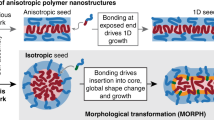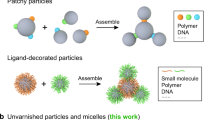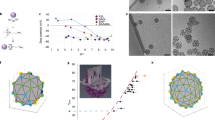Abstract
It is easy to understand the self-assembly of particles with anisotropic shapes or interactions (for example, cobalt nanoparticles or proteins) into highly extended structures. However, there is no experimentally established strategy for creating a range of anisotropic structures from common spherical nanoparticles. We demonstrate that spherical nanoparticles uniformly grafted with macromolecules (‘nanoparticle amphiphiles’) robustly self-assemble into a variety of anisotropic superstructures when they are dispersed in the corresponding homopolymer matrix. Theory and simulations suggest that this self-assembly reflects a balance between the energy gain when particle cores approach and the entropy of distorting the grafted polymers. The effectively directional nature of the particle interactions is thus a many-body emergent property. Our experiments demonstrate that this approach to nanoparticle self-assembly enables considerable control for the creation of polymer nanocomposites with enhanced mechanical properties. Grafted nanoparticles are thus versatile building blocks for creating tunable and functional particle superstructures with significant practical applications.
This is a preview of subscription content, access via your institution
Access options
Subscribe to this journal
Receive 12 print issues and online access
$259.00 per year
only $21.58 per issue
Buy this article
- Purchase on Springer Link
- Instant access to full article PDF
Prices may be subject to local taxes which are calculated during checkout



Similar content being viewed by others
References
Krishnamoorti, R. & Vaia, R. A. Polymer nanocomposites. J. Polym. Sci. Pol. Phys. 45, 3252–3256 (2007).
Mackay, M. E. et al. General strategies for nanoparticle dispersion. Science 311, 1740–1743 (2006).
Krishnamoorti, R. Strategies for dispersing nanoparticles in polymers. MRS Bull. 32, 341–347 (2007).
Bansal, A. et al. Quantitative equivalence between polymer nanocomposites and thin polymer films. Nature Mater. 4, 693–698 (2005).
Green, D. L. & Mewis, J. Connecting the wetting and rheological behaviors of poly (dimethylsiloxane)-grafted silica spheres in poly(dimethylsiloxane) melts. Langmuir 22, 9546–9553 (2006).
Bansal, A. et al. Controlling the thermomechanical properties of polymer nanocomposites by tailoring the polymer-particle interface. J. Polym. Sci. B 44, 2944–2950 (2006).
Wu, C. K., Hultman, K. L., O’Brien, S. & Koberstein, J. T. Functional oligomers for the control and fixation of spatial organization in nanoparticle assemblies. J. Am. Chem. Soc. 130, 3516–3520 (2008).
Harton, S. E. & Kumar, S. K. Mean-field theoretical analysis of brush-coated nanoparticle dispersion in polymer matrices. J. Polym. Sci. Pol. Phys. 46, 351–358 (2008).
Belkin, M., Snezhko, A., Aranson, I. S. & Kwok, W. K. Driven magnetic particles on a fluid surface: Pattern assisted surface flows. Phys. Rev. Lett. 99 (2007).
Seul, M. & Andelman, D. Domain shapes and patterns—the phenomenology of modulated phases. Science 267, 476–483 (1995).
Tang, Z. Y., Zhang, Z. L., Wang, Y., Glotzer, S. C. & Kotov, N. A. Self-assembly of CdTe nanocrystals into free-floating sheets. Science 314, 274–278 (2006).
Van Workum, K. & Douglas, J. F. Symmetry, equivalence, and molecular self-assembly. Phys. Rev. E 73, 031502 (2006).
Bedrov, D., Smith, G. D. & Li, L. W. Molecular dynamics simulation study of the role of evenly spaced poly(ethylene oxide) tethers on the aggregation of C60 fullerenes in water. Langmuir 21, 5251–5255 (2005).
Shay, J. S., Raghavan, S. R. & Khan, S. A. Thermoreversible gelation in aqueous dispersions of colloidal particles bearing grafted poly(ethylene oxide) chains. J. Rheol. 45, 913–927 (2001).
Fejer, S. N. & Wales, D. J. Helix self-assembly from anisotropic molecules. Phys. Rev. Lett. 99, 086106 (2007).
Glotzer, S. C. & Solomon, M. J. Anisotropy of building blocks and their assembly into complex structures. Nature Mater. 6, 557–562 (2007).
Lee, J. Y., Balazs, A. C., Thompson, R. B. & Hill, R. M. Self-assembly of amphiphilic nanoparticle-coil ‘tadpole’ macromolecules. Macromolecules 37, 3536–3539 (2004).
Sciortino, F., Bianchi, E., Douglas, J. F. & Tartaglia, P. Self-assembly of patchy particles into polymer chains: A parameter-free comparison between Wertheim theory and Monte Carlo simulation. J. Chem. Phys. 126, 194903 (2007).
Rabani, E., Reichman, D. R., Geissler, P. L. & Brus, L. E. Drying-mediated self-assembly of nanoparticles. Nature 426, 271–274 (2003).
Gupta, S., Zhang, Q. L., Emrick, T., Balazs, A. C. & Russell, T. P. Entropy-driven segregation of nanoparticles to cracks in multilayered composite polymer structures. Nature Mater. 5, 229–233 (2006).
Kammler, H. K., Beaucage, G., Mueller, R. & Pratsinis, S. E. Structure of flame-made silica nanoparticles by ultra-small-angle X-ray scattering. Langmuir 20, 1915–1921 (2004).
Oberdisse, J. Aggregation of colloidal nanoparticles in polymer matrices. Soft Matter 2, 29–36 (2006).
Ogawa, K., Vogt, T., Ullmann, M., Johnson, S. & Friedlander, S. K. Elastic properties of nanoparticle chain aggregates of TiO2, Al2O3, and Fe2O3 generated by laser ablation. J. Appl. Phys. 87, 63–73 (2000).
Pratsinis, S. E. Flame aerosol synthesis of ceramic powders. Prog. Energy Combust. Sci. 24, 197–219 (1998).
Sear, R. P., Chung, S. W., Markovich, G., Gelbart, W. M. & Heath, J. R. Spontaneous patterning of quantum dots at the air-water interface. Phys. Rev. E 59, R6255–R6258 (1999).
Dinsmore, A. D., Prasad, V., Wong, I. Y. & Weitz, D. A. Microscopic structure and elasticity of weakly aggregated colloidal gels. Phys. Rev. Lett. 96, 185502 (2006).
Sciortino, F., Mossa, S., Zaccarelli, E. & Tartaglia, P. Equilibrium cluster phases and low-density arrested disordered states: The role of short-range attraction and long-range repulsion. Phys. Rev. Lett. 93 (2004).
Starr, F. W., Douglas, J. F. & Glotzer, S. C. Origin of particle clustering in a simulated polymer nanocomposite and its impact on rheology. J. Chem. Phys. 119, 1777–1788 (2003).
Hooper, J. B., Bedrov, D. & Smith, G. D. Supramolecular self-organization in PEO-modified C60 fullerene/water solutions: Influence of polymer molecular weight and nanoparticle concentration. Langmuir 24, 4550–4557 (2008).
Li, C., Han, J., Ryu, C. Y. & Benicewicz, B. C. A versatile method to prepare RAFT agent anchored substrates and the preparation of PMMA grafted nanoparticles. Macromolecules 39, 3175–3183 (2006).
Bates, F. S. & Fredrickson, G. H. Block copolymers—Designer soft materials. Phys. Today 52, 32–38 (1999).
Ilavsky, J., Allen, A. J., Long, G. G. & Jemian, P. R. Effective pinhole-collimated ultrasmall-angle x-ray scattering instrument for measuring anisotropic microstructures. Rev. Sci. Instrum. 73, 1660–1662 (2002).
Beaucage, G. Approximations leading to a unified exponential power-law approach to small-angle scattering. J. Appl. Crystallogr. 28, 717–728 (1995).
Israelachvili, J. N., Mitchell, D. J. & Ninham, B. W. Theory of self-assembly of hydrocarbon amphiphiles into micelles and bilayers. J. Chem. Soc. Faraday Trans. II 72, 1525–1568 (1976).
Nagarajan, R. & Ruckenstein, E. Theory of surfactant self-assembly—a predictive molecular thermodynamic approach. Langmuir 7, 2934–2969 (1991).
Zana, R. & Talmon, Y. Dependence of aggregate morphology on structure of dimeric surfactants. Nature 362, 228–230 (1993).
Goel, V. et al. Viscoelastic properties of silica-grafted poly(styrene-acrylonitrile) nanocomposites. J. Polym. Sci. Pol. Phys. 44, 2014–2023 (2006).
Solomon, M. J., Almusallam, A. S., Seefeldt, K. F., Somwangthanaroj, A. & Varadan, P. Rheology of polypropylene/clay hybrid materials. Macromolecules 34, 1864–1872 (2001).
Kashiwagi, T. et al. Relationship between dispersion metric and properties of PMMA/SWNT nanocomposites. Polymer 48, 4855–4866 (2007).
Kashiwagi, T. et al. Nanoparticle networks reduce the flammability of polymer nanocomposites. Nature Mater. 4, 928–933 (2005).
Kausch, H. H. & Michler, G. H. Effect of nanoparticle size and size-distribution on mechanical behavior of filled amorphous thermoplastic polymers. J. Appl. Polym. Sci. 105, 2577–2587 (2007).
Ma, C. C. M., Chen, Y. J. & Kuan, H. C. Polystyrene nanocomposite materials: Preparation, morphology, and mechanical, electrical, and thermal properties. J. Appl. Polym. Sci. 98, 2266–2273 (2005).
Putt, K., Krishnamoorti, R. & Green, P. F. The role of interfacial interactions in the dynamic mechanical response of functionalized SWNT-PS nanocomposites. Polymer 48, 3540–3545 (2007).
Warrick, E. L. Rheology of filled siloxane polymers. Industrial Eng. Chem. 47, 1816–1820 (1955).
Payne, A. R. Effect of dispersion on dynamic properties of filler-loaded rubbers. J. Appl. Polym. Sci. 9, 2273 (1965).
Kluppel, M. Structure and properties of fractal filler networks in rubber. Kautsch. Gummi Kunstst. 50, 282–291 (1997).
Salaniwal, S., Kumar, S. K. & Douglas, J. F. Amorphous solidification in polymer-platelet nanocomposites. Phys. Rev. Lett. 89, 258301 (2002).
Kumar, S. K. & Douglas, J. F. Gelation in physically associating polymer solutions. Phys. Rev. Lett. 87, 188301 (2001).
Acknowledgements
The authors acknowledge financial support from the National Science Foundation (through the Division of Materials Research, DMR-0804647 (S.K.K.), a Nanoscale Science and Engineering Center, NSF Award Number DMR-0642573 (P.A., S.K.K., Y.L., B.C.B., L.S.S.) and a Materials Research Science and Engineering at Princeton (A.Z.P.)). D.A. is a member of the New York Structural Biology Center, which is a STAR Center supported by the New York State Office of Science, Technology, and Academic Research. Work benefited from the use of the Advanced Photon Source supported by the US Department of Energy, Office of Science, Office of Basic Energy Sciences, under Contract No. DE-AC02-06CH11357. V.G. and V.P. acknowledge partial support from the Welch Foundation, the US Army Research Office under Grant No. W911NF-07-1-0268 and funds made available through the CONTACT program from AFOSR. S.K.K. thanks M. Olvera (Northwestern), T. Russell (U Mass), R. Krishnamoorti (Houston) and S. Sen (Kolkota) for useful discussions and for critical comments on this paper.
Author information
Authors and Affiliations
Contributions
P.A. conducted most of the experiments in the research; S.K.K. planned the research and supervised it along with L.S.S. The paper was written by S.K.K. and J.F.D. Y.L. and B.C.B. made the functionalized particles. H.L., S.K.K., A.Z.P., V.G. and V.P. conducted the theoretical calculations reported. J.M. carried out the rheology experiments in collaboration with R.H.C. and S.K.K. D.A. helped with the TEM measurements, and J.I. and P.T. carried out the USAXS experiments and analysis.
Corresponding author
Supplementary information
Supplementary Information
Supplementary Information (PDF 1622 kb)
Rights and permissions
About this article
Cite this article
Akcora, P., Liu, H., Kumar, S. et al. Anisotropic self-assembly of spherical polymer-grafted nanoparticles. Nature Mater 8, 354–359 (2009). https://doi.org/10.1038/nmat2404
Received:
Accepted:
Published:
Issue Date:
DOI: https://doi.org/10.1038/nmat2404
This article is cited by
-
Tripod-shaped POSS compounds as single-component silsesquioxane hybrids
Polymer Journal (2024)
-
Many-body potential for simulating the self-assembly of polymer-grafted nanoparticles in a polymer matrix
npj Computational Materials (2023)
-
Molecular Simulations in Macromolecular Science
Chinese Journal of Polymer Science (2023)
-
The emergence of valency in colloidal crystals through electron equivalents
Nature Materials (2022)
-
Crystallization of nanoparticles induced by precipitation of trace polymeric additives
Nature Communications (2021)



